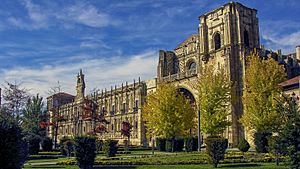Convento de San Marcos facts for kids
Quick facts for kids Convento de San Marcos |
|
|---|---|

Main façade of the convent
|
|
| Alternative names | Parador de León |
| Hotel chain | Paradores |
| General information | |
| Location | León, Spain |
| Type | Non-movable |
| Criteria | Monument |
| Designated | 24 September 1845 |
| Reference no. | RI-51-0000002 |
The Convento de San Marcos is a very important building in León, Spain. It used to be a convent, but today it is a fancy hotel called a parador. It also has a church and a museum inside. This building is one of the most important examples of Renaissance architecture in Spain. It's considered one of León's most beautiful buildings, along with the Cathedral, the Basilica of San Isidoro, and Casa Botines. It has a very detailed and decorated front, known as plateresque style.
For a short time, between 1936 and 1940, the building was used as a large prison during the Spanish Civil War. Many people were held there. It was a very difficult period in the building's long history.
The story of this building began in the 1100s. King Alfonso VII of León's sister, Infanta Sancha, gave money in 1152. She wanted a simple place built outside the city walls. This place, by the Bernesga river, was meant to be a hospital and shelter. It helped pilgrims traveling on the famous Camino de Santiago route. It was also the main home for the Order of Santiago in the Kingdom of León. In 1176, Pedro Fernández de Castro, the first leader of the Order of Santiago, was chosen here. He was buried in its church in 1184.
Building the Convento de San Marcos
By the 1500s, the old medieval building was in bad shape. So, it was taken down. A new, grander building was planned. This was possible thanks to money from Ferdinand the Catholic in 1514. Several architects worked on the project. Juan Orozco designed the church. Martin Villarreal worked on the front facade. Juan de Badajoz el Mozo designed the cloister and sacristy.
However, the new construction didn't start right away. It began later, during the time of King Charles I. We know that the main front wall of the convent was built up to the church in 1537. The church itself was ready and blessed in 1541. In the years that followed, Orozco created the sculptures for the facade. The choir area was finished. By 1549, Juan de Badajoz completed the sacristy.
Work stopped in 1566 because the religious community moved away. But when the friars returned to San Marcos in 1602, building started again. In 1615, the main staircase was built. By 1679, the last part of the cloister was finished. Finally, between 1711 and 1715, the building was greatly expanded. Another wall was built from the main entrance to the river. This new part looks very similar to the older section. It's hard to tell the two halves of the facade apart.
Today, the Convento de San Marcos is a state-owned hotel. It also has a church and a museum. It is still an important stop for people walking the Camino de Santiago.
See also
 In Spanish: Convento de San Marcos (León) para niños
In Spanish: Convento de San Marcos (León) para niños


